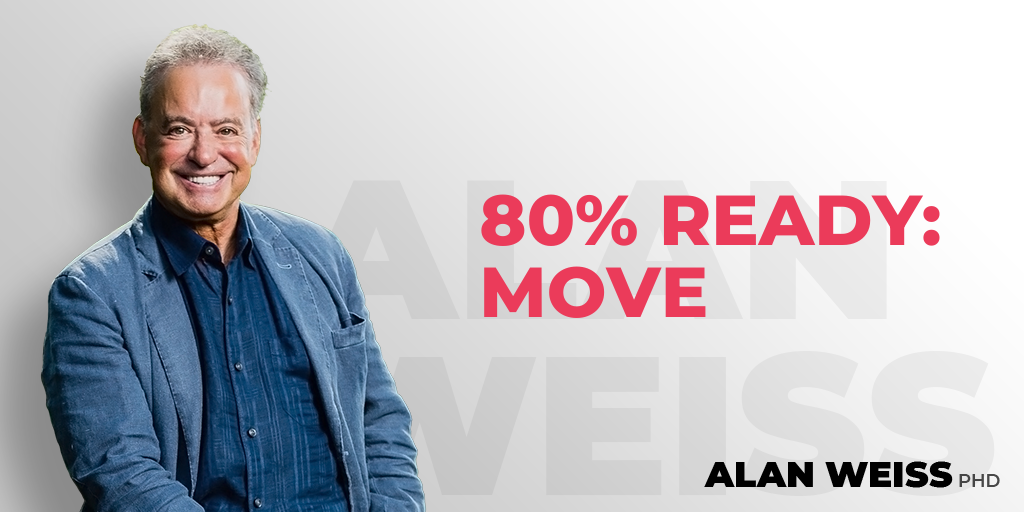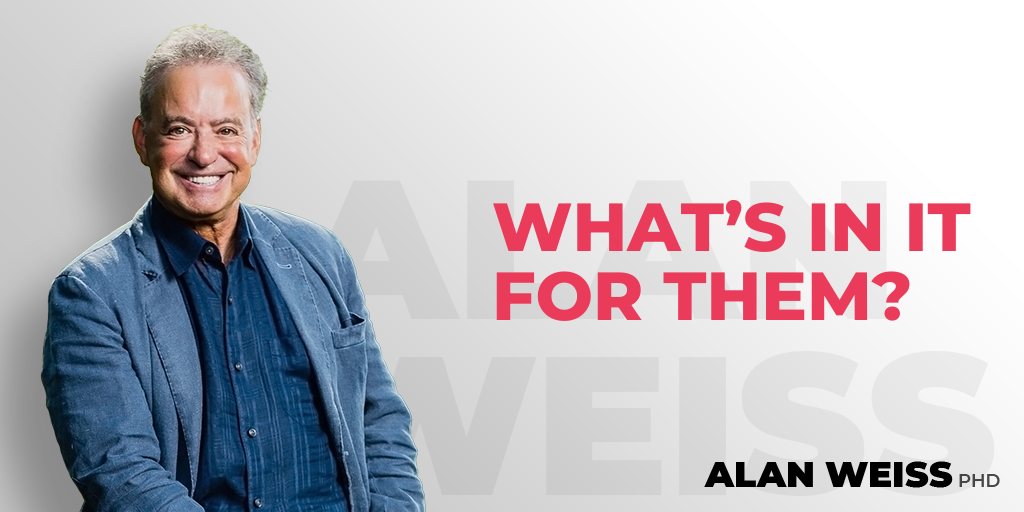101 Questions for Any Sales Situation
© Alan Weiss 2009. All rights reserved.
I. Qualifying the Prospect
This is the process of determining whether the inquiry is appropriate for your business in terms of size, relevance, seriousness, and related factors. In other words, you don’t want to pursue a lead which can’t result in legitimate—and worthwhile—business.
Questions:
1. Why do you think we might be a good match?
2. Is there budget allocated for this project?
3. How important is this need (on a scale of 1-10)?
4. What is your timing to accomplish this?
5. Who, if anyone, is demanding that this be accomplished?
6. How soon are you willing to begin?
7. Have you made a commitment to proceed, or are you still analyzing?
8. What are your key decision criteria in choosing a resource?
9. Have you tried this before (will this be a continuing endeavor)?
10. Is your organization seeking formal proposals for this work?
Key Point: You want to determine whether the potential work is large enough for your involvement, relevant to your expertise, and near enough on the horizon to merit rapid responsiveness.
II. Finding the Economic Buyer
The economic buyer is the person who can write a check in return for your value contribution. He or she is the ONLY buyer to be concerned about. Contrary to a great deal of poor advice, the economic buyer is virtually never in human resources, training, meeting planning, or related support areas.
Questions
11. Whose budget will support this initiative?
12. Who can immediately approve this project?
13. To whom will people look for support, approval, and credibility?
14. Who controls the resources required to make this happen?
15. Who has initiated this request?
16. Who will claim responsibility for the results?
17. Who will be seen as the main sponsor and/or champion?
18. Do you have to seek anyone else’s approval?
19. Who will accept or reject proposals?
20. If you and I were to shake hands, could I begin tomorrow?
Key Point: The larger the organization, the more the number of economic buyers. They need not be the CEO or owner, but must be able to authorize and produce payment. Committees are never economic buyers.
III. Rebutting Objections
“Obstacles are those terrible things you see when you take your eyes off the goal,” said philosopher Hannah More. Objections are a sign of interest. Turn them around to your benefit. Once you demolish objections, there is no longer a reason not to proceed in a partnership.
Questions (in responding to an economic buyer’s objections)
21. Why do you feel that way? (Get at the true cause.)
22. If we resolve this, can we then proceed? (Is this the sole objection?)
23. But isn’t that exactly why you need me? (The reversal approach.)
24. What would satisfy you? (Make the buyer answer the objection.)
25. What can we do to overcome that? (Demonstrate joint accountability.)
26. Is this unique? (Is there precedent for overcoming it?)
27. What’s the consequence? (Is it really serious or merely an annoyance?)
28. Isn’t that low probability? (Worry about likelihoods, not the remote.)
29. Shall I address that in the proposal? (Let’s focus on value.)
30. Why does it even matter in light of the results? (The ROI is the point.)
Key Points: Don’t be on the defensive by trying to slay each objection with your sword, or you’ll eventually fall on it. Embrace the buyer in the “solutions,” and demonstrate that some objections are insignificant when compared with benefits (e.g., there will always be some unhappy employees in any change effort).
IV. Establishing Objectives
Objectives are the outcomes which represent the client’s desired and improved conditions. They are never inputs (e.g., reports, focus groups, manuals) but rather always outputs (e.g., increased sales, reduced attrition, improved teamwork). Clear objectives prevent “scope creep” and enable a rational engagement and disengagement to take place, resulting in much greater consulting efficiency and profit margins. (Note that items IV, V, and VI—objectives, measures, and value—are the basis of conceptual agreement.)
Questions
31. What is the ideal outcome you’d like to experience?
32. What results are you trying to accomplish?
33. What better product/service/customer condition are you seeking?
34. Why are you seeking to do this (work/project/engagement)?
35. How would the operation be different as a result of this work?
36. What would be the return on investment (sales, assets, equity, etc.)?
37. How would image/repute/credibility be improved?
38. What harm (e.g., stress, dysfunction, turf wars, etc.) would be alleviated?
39. How much would you gain on the competition as a result?
40. How would your value proposition be improved?
Key Points: Most buyers know what they want but not necessarily what they need. By pushing the buyer on the end results you are helping to articulate and formalize the client’s perceived benefits, thereby increasing your own value in the process. Without clear objectives you do not have a legitimate project.
V. Establishing Metrics
“Metrics” are measures of progress toward the objectives, which enable you and the client to ascertain the rate and totality of success. They assign proper credit to you and your efforts, and also signify when the project is complete (objectives are met) and it is proper to disengage.
Questions
41. How will you know we’ve accomplished your intent?
42. How, specifically, will the operation be different when we’re done?
43. How will you measure this?
44. What indicators will you use to assess our progress?
45. Who or what will report on our results (against the objectives)?
46. Do you already have measures in place you intend to apply?
47. What is the rate of return (on sales, investment, etc.) that you seek?
48. How will we know the public, employees, and/or customers perceive it?
49. Each time we talk, what standard will tell us we’re progressing?
50. How would you know it if you tripped over it?
Key Points: Measures can be subjective, so long as you and the client agree on who is doing the measuring and how. For example, the buyer’s observation that he or she is called upon less to settle “turf” disputes and has fewer complaints from direct reports aimed at colleagues are valid measures for the objective of “improved teamwork.”
VI. Assessing Value
Determining the value of the project for the client’s organization is the most critical aspect of conceptual agreement and pre-proposal interaction. That’s because when the buyer stipulates to significant value, the fee is placed in proper perspective (ROI) and is seldom an issue of contention. Conversations with the buyer should always focus on value and never on fee or price.
Questions
51. What will these results mean for your organization?
52. How would you assess the actual return (ROI, ROA, ROS, ROE, etc.)?
53. What would be the extent of the improvement (or correction)?
54. How will these results impact the bottom line?
55. What are the annualized savings (first year might be deceptive)?
56. What is the intangible impact (e.g., on repute, safety, comfort, etc.)?
57. How would you, personally, be better off or better supported?
58. What is the scope of the impact (on customers, employees, vendors)?
59. How important is this compared to your overall responsibilities?
60. What if this fails?
Key Points: Subjective value (stress alleviated) can be every bit as important as more tangible results (higher sales). Never settle for “Don’t worry, it’s important.” Find out how important, because that will dictate the acceptable fee range.
VII. Determining the Budget Range
Too much guessing takes place in the absence of a general understanding about how much the prospect intends to invest (prior to understanding the full value proposition). In many cases, the budget is fixed and entirely inappropriate, and in others it represents a better understanding of the ROI than that of the consultant! (Don’t forget, this presupposes you’re talking to an economic buyer.)
Questions
61. Have you arrived at a budget or investment range for this project?
62. Are funds allocated, or must they be requested?
63. What is your expectation of investment required?
64. So we don’t waste time, are there parameters to remain within?
65. Have you done this before, and at what investment level?
66. What are you able to authorize during this fiscal year?
67. Can I assume that a strong proposition will justify proper expenditure?
68. How much are you prepared to invest to gain these dramatic results?
69. For a dramatic return, will you consider a larger investment?
70. Let’s be frank: What are you willing to spend?
Key Points: There is nothing wrong with exceeding the budget expectation if you muster a strong enough value proposition. But don’t even proceed with a proposal if the prospect has a seriously misguided expectation of the investment need, or simply has an inadequate, fixed budget.
VIII. Preventing Unforeseen Obstacles
As comedienne Gilda Radnor used to say, “It’s always something.” Inevitably, it seems, the best laid plains are undermined by objections, occurrences, and serendipity from left field. Fortunately, there are questions to establish some preventive actions against even the unforeseen.
Questions
71. Is there anything we haven’t discussed which could get in the way?
72. In the past, what has occurred to derail potential projects like this?
73. What haven’t I asked you that I should have about the environment?
74. What do you estimate the probability is of our going forward?
75. Are you surprised by anything I’ve said or that we’ve agreed upon?
76. At this point, are you still going to make this decision yourself?
77. What, if anything, do you additionally need to hear from me?
78. Is anything likely to change in the organization in the near future?
79. Are you awaiting the results of any other initiatives or decisions?
80. If I get this proposal to you tomorrow, how soon will you decide?
Key Points: Make sure that your project isn’t contingent upon other events transpiring (or not transpiring). If the buyer is holding out on you, these questions will make it more difficult to dissemble. Build into your proposal benefits to outweigh the effects of any external factors.
IX. Increasing the Size of the Sale
Once conceptual agreement is gained, it makes sense to capitalize on the common ground and strive for the largest possible relationship. Most consultants don’t obtain larger contracts because they don’t ask for or suggest them. You can’t possibly lose anything attempting to increase the business at this juncture.
Questions
81. Would you be amenable to my providing a variety of options?
82. Is this the only place (division, department, geography) applicable?
83. Would it be wise to extend this through implementation and oversight?
84. Should we plan to also coach key individuals essential to the project?
85. Would you benefit from benchmarking against other firms?
86. Would you also like an idea of what a retainer might look like?
87. Are there others in your position with like needs I should see?
88. Do your subordinates possess the skills to support you appropriately?
89. Should we run focus groups/other sampling to test employee reactions?
90. Would you like me to test customer response at various stages?
Key Points: If you don’t ask, you don’t get. Don’t throw everything including the kitchen sink into your proposal in an attempt to justify your fee. Instead, “unbundle” what you’re capable of providing and add them back in at additional fee.
X. Going for the Close
Home stretch, but not across the finish line. Runners who slow up at the approaching tape lose to someone else with a better late “kick.” Run through the tape at full speed by driving the conversation right through the close of the sale and the check clearing the bank.
Questions
91. If the proposal reflects our last discussions, how soon can we begin?
92. Is it better to start immediately, or wait for the first of the month?
93. Is there anything at all preventing our working together at this point?
94. How rapidly are you prepared to begin once you see the proposal?
95. If you get the proposal tomorrow, can I call Friday at 10 for approval?
96. While I’m here, should I begin some of the preliminary work today?
97. Would you like to shake hands and get started, proposal to follow?
98. Do you prefer a corporate check or to wire the funds electronically?
99. May I allocate two days early next week to start my interviews?
100. Can we proceed?
Key Points: There is never a better time than when you’re in front of the buyer and he or she is in agreement and excited about the project. Even without a proposal, beginning immediately “pours cement” on the conceptual agreement and greatly diminishes the possibility of being derailed by surprise.
XI. The Most Vital Question
All of the preceding 100 questions are actually based on the reaction to one question which we often fail to ask of the most difficult person of all. And unlike most of the prior inquiries, it’s a simple binary question, with a clear “yes or no” response.
Question
101. Do you believe it yourself?
Key Points: The first sale is always to yourself.
© Alan Weiss 2009. All rights reserved.







Dennis
Great post. Haven’t read anything as good in awhile anywhere. Thanks.
(I wonder if the fact that I agree with everything is because I am getting better or you are getting worse … (joking)
Alan Weiss
Glad you liked it. This business is not rocket science.
jim Powell
Brilliant, really brilliant – I have just been re-working my pre sales call plan to qualify prospects hard and find the real probelm – I only got to 30 questions – I know now what I am missing – if you miss a question the deal just goes into a stall, right.
A favourite question of mine is “what have I not asked you that I should have ? i.e. 77 on your list, or I ask myself, is something not being said that should be, sometimes I feel that something is not being said that should be, I feel it in my gut somewhere. When I find it I must ask it however uncomfortable.
I wonder if I could send some of my questions out before a meeting?
Alan Weiss
I think that would be a huge mistake. These are supposed to be conversational, not a test, a relationship, not an interrogation. By the way, I hate questions like “What should I have asked?” and “What have I missed”?, etc., because they expect the prospect to do your work for you. You need to be sharper than that, that’s amateur stuff.
jim Powell
The reason I ask these question is because it does get the prospect to do some work, true. Then the prospect can never come back with “I missed something”, you also then never miss any objection they may have to doing business with you, very similar to your question #77, yours is about you, mine is about them. It also helps develop conversation and the relationship. I never assume to know more about the prospect then they do.
David Sandler in, You Can’t Teach a Kid to Ride a Bike in a Seminar – talks about getting the prospect to do the work as they are best qualified to overcome their own objections.
I can handle being called an amateur by the way.
Alan Weiss
I don’t agree with Sandler, this is a very amateur approach. The client can always claim that you missed something.
It’s intellectual vacuity to ask someone else “What have I missed” as if they should be reading your mind and providing you with help. That’s why I have all those questions.
You’ll never know more about the prospect, but you do know more about your process. You’re getting confused between content and process.
Jim Powell
ah! I agree with David Sandler, so we will disagree, no harm is that is there?
I think Sandler is a professional approach. I used to be a Dale Carneigie style sales person but find the Sandler system work better for me. Nothing wrong at all with Dale Carneige by the way, it’s just old and everyone uses it and it uses old fashion trial closes for example and other tricky methods.
I dont want the prospect to read my mind at all, I want to read theirs, I am going to need help doing that. They are ALWAYS only too happy to help in my experience. It doesn’t mean I don’t have tons of others questions for them.
I still like what you have to say and your approach and will take it on board, I wouldn’t be here now if I didn’t would I?
I’m not one of those who are itching with a ego style fight with AW on a blog. I can see what you does works, cars, house, lifestyle and best selling books etc.
I leave you to have the last word.
Alan Weiss
No need for a “last” word, I respect your opinion. I just rebel against “systems.” But I never argue with success.Thanks for contributing here.
Brian Roberts
The few minutes one can take to read, print and practice this list can generate a tremendous ROI. If used correctly, I am sure the application of this list can contribute to millions of dollars in business. One of the most concise, valuable things I’ve stumbled upon. Thank you Alan!